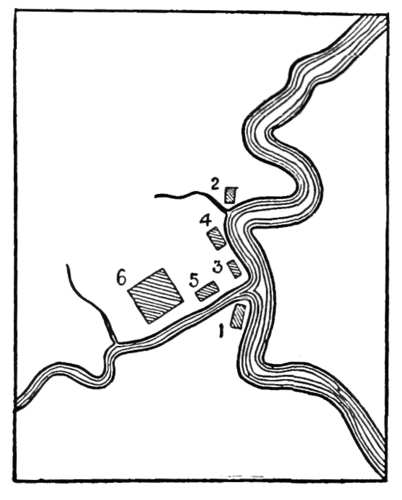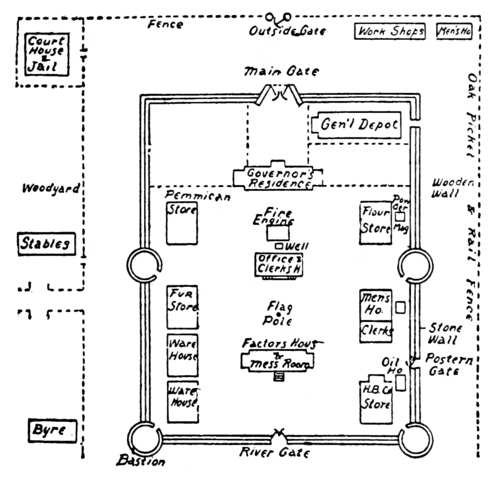|
Stone forts and ermined judges were not,
to the mind of the unbridled and ungovernable Metis. True, the French
mind has a love for show and circumstance and dignity of demeanor, but
the conviction had taken hold of the people of Red River, and especially
of the French half-breeds, that these meant curtailment of their
freedom. They felt the dice were loaded against them.
But, now, in the year after Sinclair
and his friends had shown such a firm front to Governor Christie, and
when something like a feudal system was being introduced into the Red
River Settlement, a new surprise came upon French and English alike.
This was immediately after the terrible visitation of a plague, which
had cut down one-sixteenth of the whole population. It was the arrival
of a party of the Sixth Royal Regiment of Foot, along with artillery and
engineers, amounting in all to five hundred souls. The breath of the
people was taken away by this demonstration of force, and a chronicler of
the time says: "From the moment they arrived the high tone of lawless
defiance and internal disaffection raised by our people against the laws
and the authorities of the place were reduced to silence." Colonel
Crofton, in command of the troops, was appointed Governor of the
Settlement, and he proved a wise and honorable administrator. The
regiment gained golden opinions from the people, and as they spent
during their short stay of two years, a sum of £15,000 in supplies, it
was, indeed, a golden age for the hard-working Colonists. The leaving of
the regiment was regretted by the Colony.
Having now entered on a career of
government by force, it would not do to let it drop. Hence the
authorities enlisted in Britain a number of old pensioners, and under
command of Major Caldwell, who was also to act as Governor of the
Settlement, sent out, in each of two successive years, some seventy of
these discharged soldiers to act as guardians of the peace. It was
pretty well agreed that these men, to whom were given holdings of small
pieces of land to the west of Fort Garry, now in the St. James District
of Winnipeg, were simply imitators in conduct and disposition of the De
Meurons, who had so vexed the Colonists. Major Caldwell, too, by his
lack of business habits and his selfishness, alienated all the leading
men of the Colony, so that they refused to sit with him in Council. It
was the common opinion that the turbulence and violence of the
pensioners was so great that, as one of the Company said, "We have more
trouble with the pensioners than with all the rest of the Settlement put
together." The pensioners were certainly absolutely useless for the
purpose for which they had been sent, that is to preserve order in the
country. The Metis, at any rate, spoke of them with derision.

PLAN OF FORT GARRY and of the other forts of Winnipeg.
1, Fort Rouge; 2, Fort Douglas; 3, Fort Gibraltar; 4, Fidler's Fort;
5, First Fort Garry; 6, Fort Garry.
In the year following the removal of
the troops the policy of preventing the French half-breeds
from buying and selling furs with the Indians was being carried out by
Judge Thom, the relentless ogre of the law. Four men of the Metis had
been arrested; of these the leader was William Sayer. He was the
half-breed son of an old French bourgeois of the Northwest Company. He
had been liberated on bail, and was to come up for trial in May. The
charge against him was of buying goods with which to go on a trading
expedition to Lake Manitoba.
Possibly the case would be easily disposed
of, and most likely dismissed with a trifling fine, although it was true
that Sayer had made a stiff resistance on his being arrested. This
violent resistance was but an example of the bitter and dangerous spirit
that was developing among the Metis.
A brave and restless man was now
growing to have a dominating influence over the French half-breeds. This
was Louis Riel, a fierce and noisy revolutionist, ready for any
extremity. He was a French half-breed, was owner of a small flour mill
on the Seine River, and he was the father of the rebel chief of later
years. The day fixed for the Sayer trial by the legal authorities was a
most unfortunate one. It was on May 17th, which on that year was
Ascension Day, a day of obligation among the Catholic people of the
Settlement. It was noticeable that
there was much ferment in the French parishes. Louis Riel, who was a
violent, but effective speaker, of French, Irish and Indian descent,
busied himself in stirring up resistance. The fact that it was a Church
day for the Metis made it easy for them to gather together. This they
did by hundreds in front of the St. Boniface Cathedral, where, piling up
their guns, with which all the men were armed, at the Church door, they
then entered and performed their sacred duties. At the close of the
service, Riel, "the miller of the Seine," made a fiery oration,
advocating the rescue of their compatriot Sayer, who was to be held for
trial at the Court House. A French sympathizer said of this public
meeting: "Louis Riel obtained a veritable triumph on that occasion, and
long and loud the hurrahs were repeated by the echoes of the Red River."
And now, under Riel's direction, by
a concerted action, movement of the whole body was made to cross the Red
River and march to the Court House, which stood beside the wall of Fort
Garry. To allow the five hundred men to cross easily, Point Douglas was
selected, and here by ferry boats, said to have been provided by James
Sinclair, the English half-breed leader of whom we have spoken, the
party crossed, and worked up to the highest pitch of excitement, stalked
up the mile or two to the Court House.

PLAN OF FORT GARRY
South portion with stone wall and bastions built in 1835.
North portion with wooden wall and stone north gate still standing,
built in 1850.
Though somewhat anxious, the
Governor and Court officials passed through the excited crowd which
surrounded the Court House. It was expected that the Governor would
order out a guard of pensioners to protect the Court, but he had
dispensed with this, and so he, Recorder Thom,
and the Magistrate, took their seats upon the elevated platform of
Justice precisely at eleven o'clock. Sayer's case was called first, but
he was held by the Metis outside of the Court room. Other unimportant
business was then taken up until one o'clock. An Irish relative of old
Andrew McDermott, named McLaughlin, attempted to interfere, but was
instantly suppressed. The Court then sent a suggestion to the Metis that
they should appoint a leader with a deputation to enter the Court room
with Sayer and state their case. This proposal was accepted, and James
Sinclair, the English half-breed leader, undertook the duty. Sayer was
then brought in, guarded by twenty of his compatriots, fully armed,
while fifty Metis guards stood at the gates of the Court House
enclosure. An attempt was then made to select a jury, but it was
fruitless. Sayer next confessed that he had traded for furs with an
Indian. The Court then gave a verdict of guilty, whereupon Sayer proved
that a Hudson's Bay officer named Harriott, had given him authority to
trade. The other three cases against the Metis were not proceeded with,
and Governor, Recorder, officials and spectators all left the Court
room, the mob being of the impression that the prisoners had been
acquitted, and that trading for furs was no longer illegal. Though this
was not the decision yet the crowd so took it up, and made the
welkin ring with shouts (Le Commerce est libre, vive la liberté)
"Commerce is free, long live liberty."
The Metis then crossed the river to St.
Boniface, and after much cheering, fired several salutes with their
guns. It was their victory, but it was one in which the vast mass of the
English-speaking rejoiced for the bands of tyranny were broken. Judge
Thom, under instructions from Governor Simpson, never acted as Recorder
again, but was simply Secretary of the Court, and another reigned in his
stead. After this the Court was largely without authority, and as has
been said the rescue of prisoners was not an infrequent occurrence in
the future life of the Settlement. |
